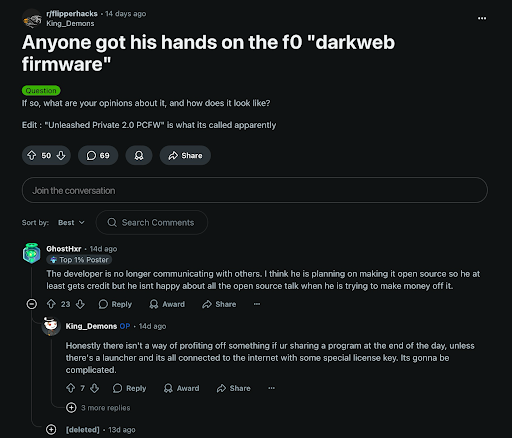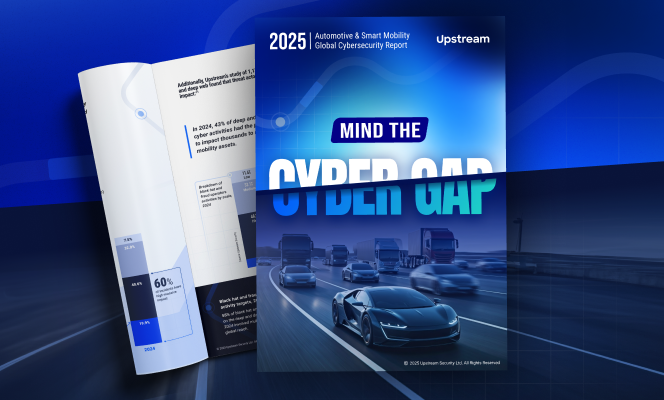

Flipper Zero and the Rise of “Unleashed 2.0”: Why Automotive Cybersecurity Needs to Look Beyond the Perimeter
Vehicles increasingly rely on wireless technologies, from RFID and Sub-GHz radio signals used in remote keyless entry and ignition to NFC-based digital keys in newer models. These protocols underpin convenience features, but they are also increasingly targeted by adversaries.
The Flipper Zero, a pocket-sized multipurpose device originally marketed for security testing and education, is an important example of this rising trend. While its official firmware restricts misuse, underground modifications are transforming Flipper into a low-cost platform for vehicle attacks.
 Source: Tiktok
Source: Tiktok
From Open Source to Dark Web Exploits
The community-driven Unleashed firmware was built by hobbyists to expand Flipper’s support for additional frequencies and protocols, keeping the project open and transparent. However, in underground markets, a more sinister evolution has emerged: Unleashed 2.0 (also known as PCFW 2.0).
Unlike the free community build, Unleashed 2.0 is marketed on dark web forums as a serialized commercial product, complete with tiered pricing: starting at $600 and rising $2000 for a DIY relay attack kit or $4000 for an assembled kit, claiming up to 150m signal extension.
This mirrors the structure of legitimate software businesses, signaling a professionalization of automotive-focused cybercrime.
Unleashed 2.0 introduces two main categories of attack:
Rolling Code Exploitation:
- Records legitimate key fob transmissions
- Analyzes the sequence to predict future unlock codes
- Injects those codes to gain unauthorized access
In effect, attackers “learn” the combination to the digital lock after observing it in use.
Relay Attacks:
- Captures and extends the car’s “key nearby?” signal
- Relays it to the actual key inside a home or office
- Sends the legitimate key’s reply back to the car
- The vehicle unlocks and starts, believing the key is present
While relay attacks are not new, their pairing with low-cost consumer hardware like Flipper lowers the barrier of entry significantly.
 Source: Reddit
Source: Reddit
The Democratization of Attack Methods Carries a Significant Impact on Connected Vehicles
The transformation of the Flipper Zero from a niche security-testing gadget into a commercialized dark web tool signals a new chapter in the automotive threat landscape. What once required expensive equipment and deep technical expertise can now be achieved with a low-priced consumer device and an illicit firmware upgrade. In the hands of threat actors, this combination becomes a powerful theft kit. Upstream’s cyber threat intelligence team, specialized in automotive cyber threats, found evidence for a widespread use of Flipper Zero, which can be found in multiple deep web source, including several popular code repositories, social media channels and instant messaging platforms.
What makes this evolution particularly concerning is the professionalization of the ecosystem around it. Underground sellers are no longer just sharing exploits in hidden forums, they are running structured businesses. They provide serialized firmware packages, regular updates, and even customer support, all with the explicit goal of monetizing vehicle exploitation. This level of organization blurs the line between hobbyist tinkering and professional cybercrime.
Equally troubling is the breadth of impact. The dark web marketing materials for Unleashed 2.0 claim compatibility with vehicles across European, American, and Asian OEMs, extending beyond passenger cars into commercial fleets. For an industry racing toward connected and autonomous mobility, this highlights a sobering reality: the same consumer-grade tools that empower security researchers can just as easily be repurposed at scale by adversaries.
Building a ‘Threat Intel First’ Cyber Resilience Strategy
For cybersecurity teams, the rise of Unleashed 2.0 is a reminder that resilience requires more than patching vulnerabilities, it demands a proactive, layered defense. At the technical level, vehicle systems must evolve to withstand both traditional and emerging attacks. Stronger encryption and rolling code algorithms, coupled with anomaly detection that flags unusual signal behavior, can help limit exposure. Fail-safes capable of identifying and interrupting relay-style intrusions should be built into next-generation systems.
Yet technology alone is not enough. To stay ahead of adversaries, organizations must look outward, integrating threat intelligence into their security operations. Monitoring dark web marketplaces, tracking discussions, and analyzing threat actor sentiment provide early warning signals that can guide product security roadmaps and incident response planning.
Collaboration is equally critical. No single OEM or supplier can address this challenge in isolation. Intelligence sharing across manufacturers, suppliers, insurers, and law enforcement can help contain risks before they scale. Industry organizations such as the Auto-ISAC should be leveraged to accelerate knowledge exchange and develop collective countermeasures.
Finally, the human element must not be overlooked. Security teams need hands-on experience testing against the very tools being used in the wild. By embedding these practices across the organization, the industry can move beyond reactive fixes toward true resilience.

